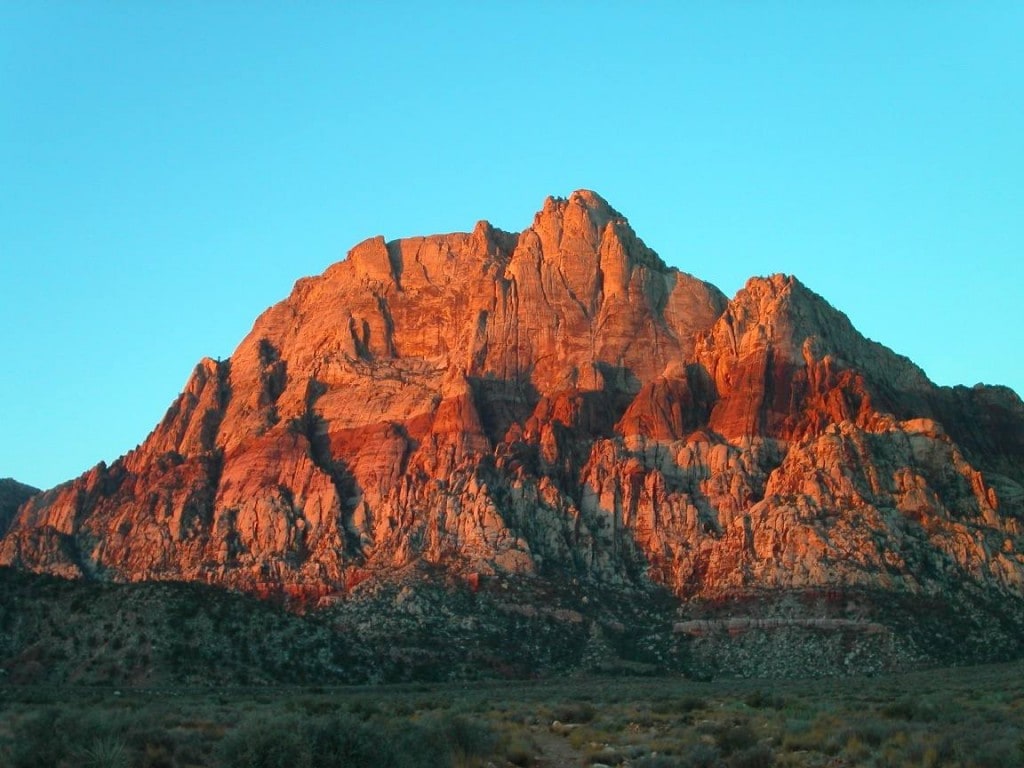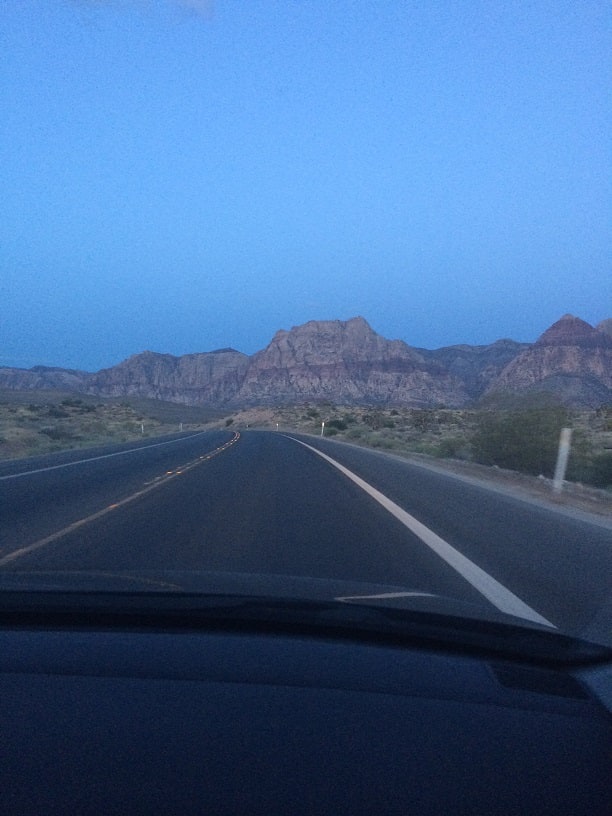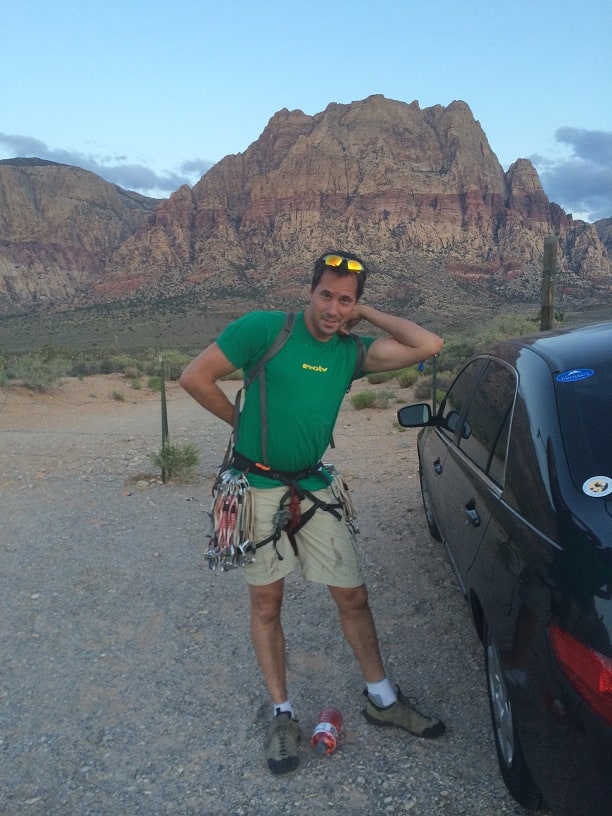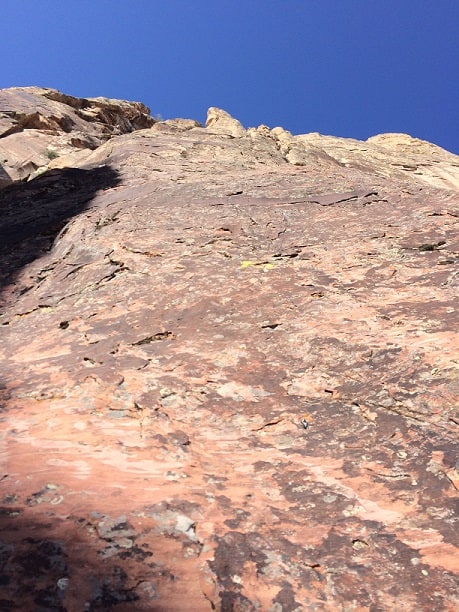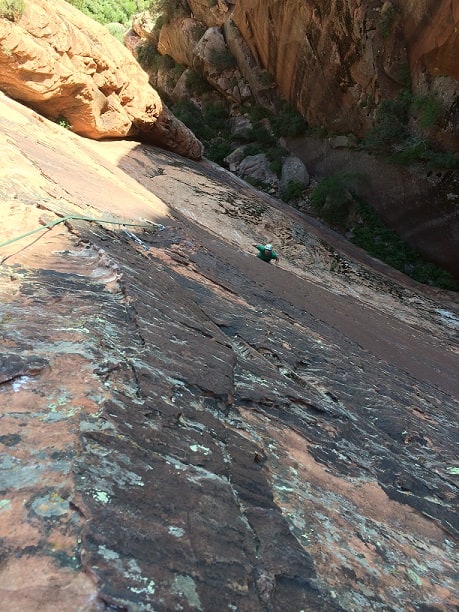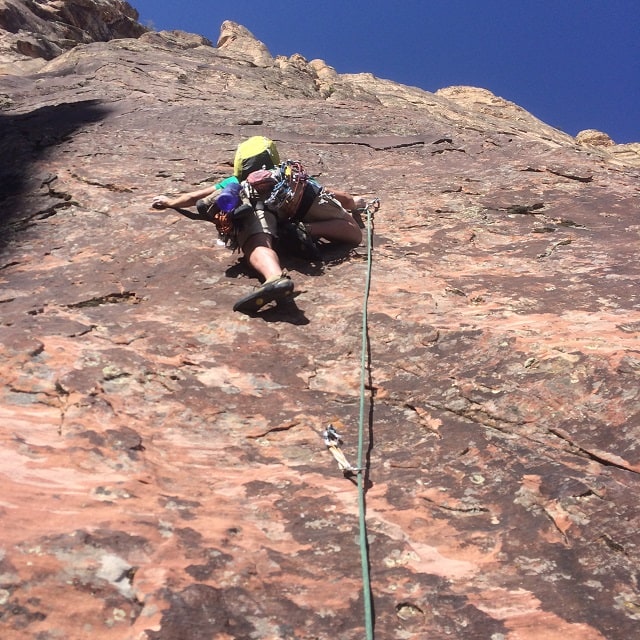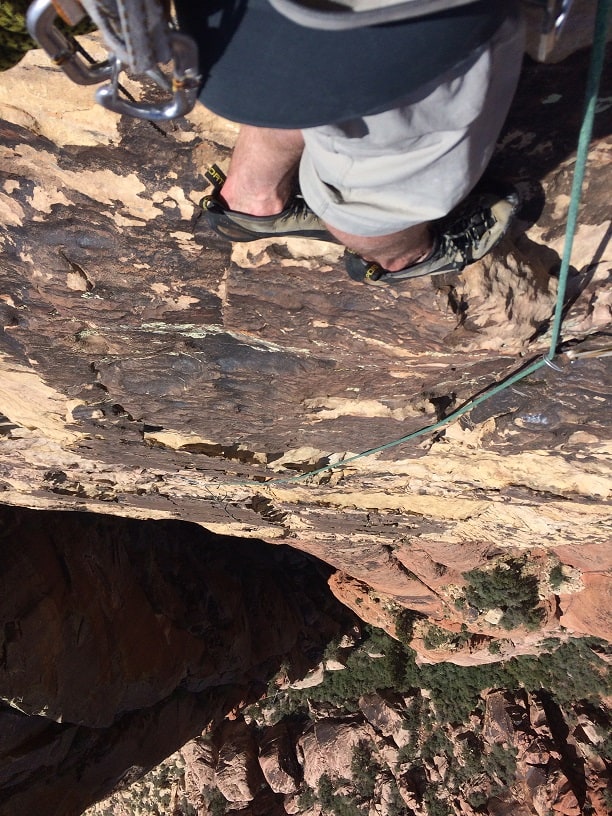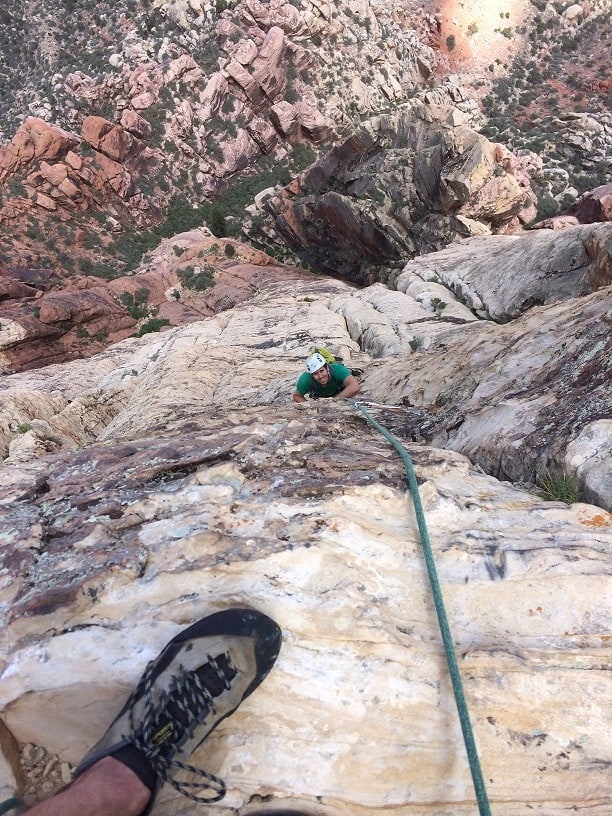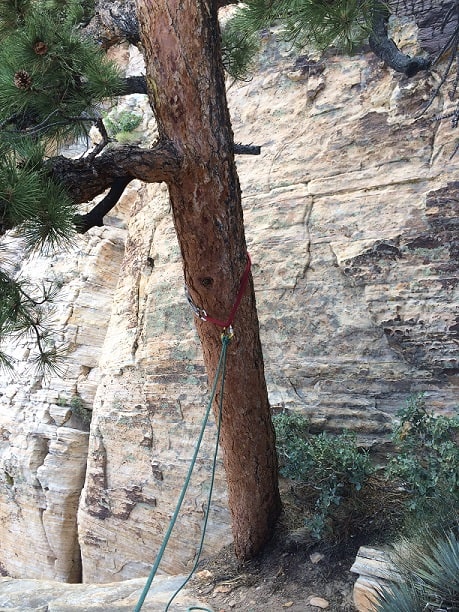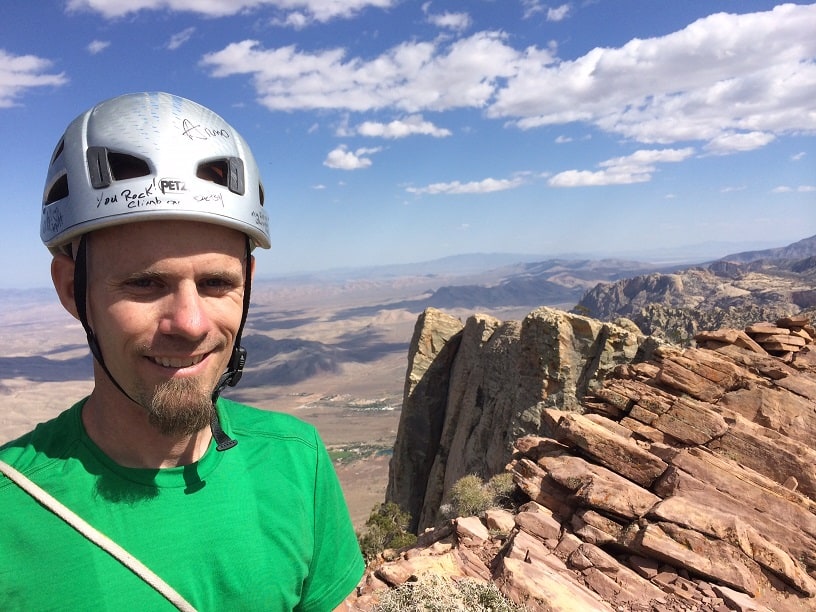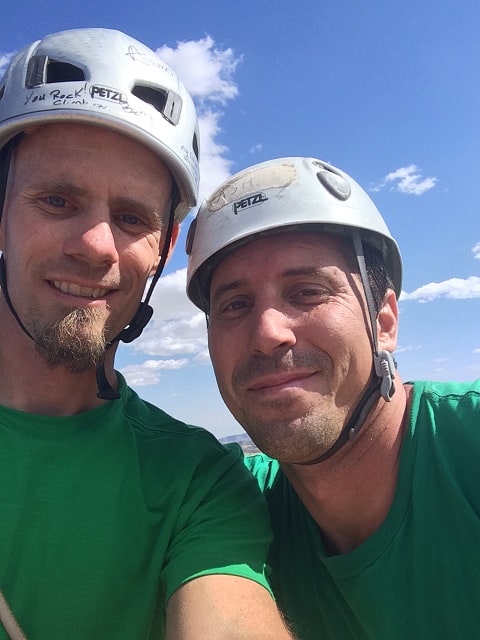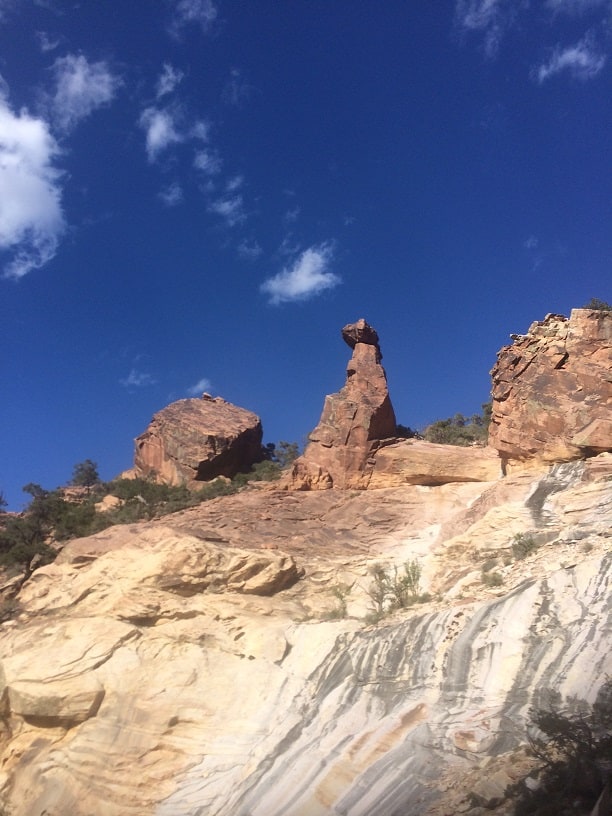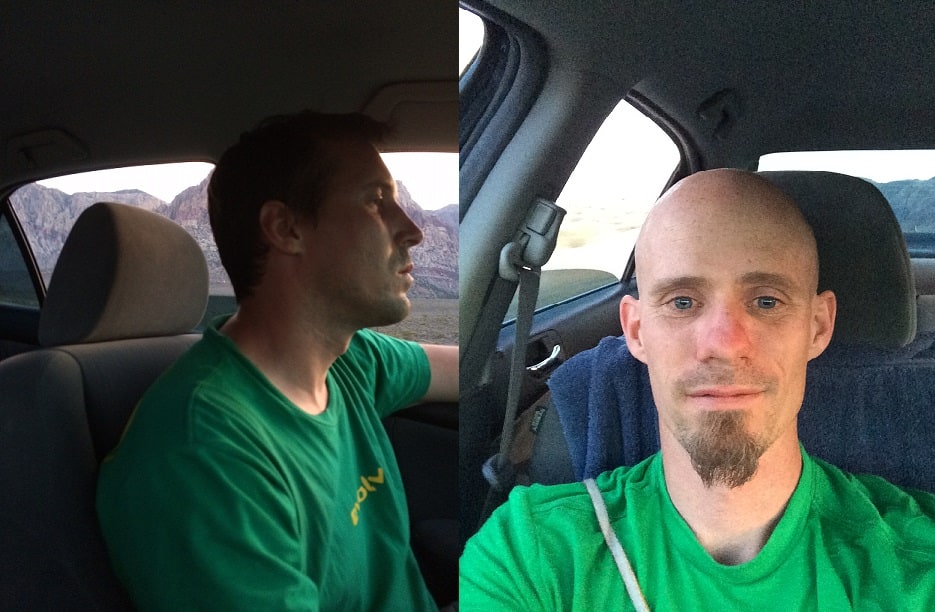Trip Report: Inti Watana to Res Arete link-up, 5.10 Grade V rock climbing day
The idea was to climb Mt. Wilson, the tallest mountain in the Red Rock Canyon area, by linking up two routes: Inti Watana and Resolution Arete. Between these two climbs, my good friend and climbing partner Ash and I were looking at approximately 2,800 vertical feet of continuous climbing. What’s not to like? The route ascends from the ground to the very top of the highest point on the picture below.
I headed to Las Vegas on the infamous Interstate 15 North from Victorville after work on Friday afternoon. Memorial Day weekend traffic. Ugh.. The driving actually wasn’t horrible. Well, it wasn’t “as horrible as usual”, which technically made the drive a success. Only 20 miles of stop and go this time. On Saturday, my friend Ash and I met up for a “warm up session” by climbing The Fox, an excellent 150 ft tall 5.10+ corner crack. I managed to huff and puff my way through an onsight of the route. Ash followed up, and we decided to call it a day. Sunday was coming, and Sunday promised to be a very full climbing day. After a quick BBQ and a few spuds (seems traditional before a big rock climbing day), I went back to Laura’s house for some zzz’s. This is when the trip got interesting. I’m not a “dog hater”, I actually do like dogs, I just don’t like small, hyper insecure dogs with competition complexes with other pets. Laura’s dog definitely falls into the “all of the above” category for this type of dog. It eats the cat’s food. Anyway, enough said about that. The dog is allowed to sleep on the bed, and the dog only sleeps for about an hour before it walks across the bed and hops onto the floor. 15 minutes later, the dog hops back up onto the bed and walks around to find a “good spot”. This always wakes me up. At one point during the very brief night, I woke up to a very strange noise. It sounded like someone trying to chew water from a soup ladle while standing on their head. After about 15 minutes of this, I had to see what the hell this noise was. I looked over the side of the bed, and the dog was laying on the floor apparently looking at the ceiling and concentrating very hard. I watched as the dog hucked up some cat food into its mouth, and then carefully swallowed it back down without losing any on the floor. Lovely. The next time the dog hopped back up onto the bed, I booted it off. I think it flew about 5 horizontal feet before it hit the floor.
My alarm went off at 4 AM. I think I slept maybe 4 hours, 5 tops. I wasn’t very happy… Laura made me some breakfast, though, which was awesome! Sometimes I wonder if I might be some sort of nutritional experiment she “plays with”. She knows a lot more about nutrition than I do, and sometimes I wonder if what she feeds me is for my benefit, or possibly hers.. Today, she gave me a smoothie that tasted “interesting”. She asked how it was, and if it tasted strange, and I said “it tastes all right”. After I finished it, she confessed that the ingredients included some joint juice, a few different types of berries, and something else I forget (probably bee pollen). I figured it had to be good for me; all that stuff sounds healthy! I drove over to Ash’s house to meet up. He said he’d been up since 3:30 or so; he didn’t sleep well either. Today was going to be a long, long day. We drove into the park as the sun started to come up and arrived at the trail head around 5:15. Mount Wilson loomed against the skyline. We started hiking at 5:30. We were on our way!
Red Rock approaches can be pretty gnarly. This one was no exception. It took us about 2 hours to get to the bottom of the climb from the car, with a couple rest stops and hydration breaks. “The trail was not necessarily marked very well. Or maybe it was and we just lost track of it.” These two statements are standard affair on most approaches in Red Rock, unless you have done the approach once or twice before. However, I believe we did fairly well on the approach. We didn’t over-exert ourselves, although we were both sweating profusely by the time we arrived at the bottom of the climb. Over-exertion on approach hikes can lead to lack of energy while climbing, especially as the day gets longer. In all actuality, the climbing begins with the approach hike as soon as you leave your car. The entire day should be considered one long energy burning session requiring efficient use of time and energy. There is only “x” amount of gas (energy) in the tank, and if you floor it unnecessarily, your “gas mileage” goes way down. Since we were going to top out, we didn’t carry large packs, but rather small leader/follower packs who’s primary contents were water and a couple snacks. We wore our harnesses on the hike in, and racked all the gear. I brought 3 liters of water, and Ash brought 3 liters and two sports drinks. Our rack consisted of 19 draws and a single rack up to #4 camalot and nuts. We brought a single 70 m rope. Carrying only one 70 m rope with us meant that the only way off the route was to top out and walk off. We had no way to bail via rappel. One of the pitches was 165 feet long. A 165 foot pitch requires 330 feet of rope to rappel down. Our single 70 m gave us only 230 ft. Thus, we were quite committed in our plan of topping out and walking off. We were quite aware of this fact, and we were mentally prepared to do what it took to get to the top of the climb, no matter what happened. There was a bit of 5th class we had to negotiate as we approached the climb, and since it was very easy, we solo’d up. Sometimes this can be fun. Sometimes the amount of loose rock in such situations can make soloing quite heady. We managed to negotiate the 5th class safely and made our way to the bottom of the climb.
At the bottom of the climb, we rested for a bit in the shade. The high for the day was projected to be over 90, and we certainly could feel the heat. I could also feel something in my bowels growling/moving and advising me to consider the consequences of ignoring the warning. That smoothie was not going to wait. I purged in the vicinity and told Ash, “Don’t turn around. You will probably never rid yourself of the horrific image.” Although green is my favorite color, and it is a trendy thing to be right now, it is not something I consider normal in a bowel movement. Must have been something in that smoothie… Our approach to the climb was to “link” as many pitches as possible by utilizing the entire length of the 70 m rope. Linking pitches means a lead climber will combine two pitches into one, leading through a typical belay spot and continuing to the next belay. Linking pitches greatly reduces the amount of time spent at belays and thus on the climb. When you skip a belay, you can shave as much as 10-20 minutes off of your route. If you can skip 3 belays, you can gain 30-60 minutes of time. It also makes for very long pitches, which can be quite fun and quite exhausting at the same time. Our plan was to link pitches 1&2, 3&4, 5&6, 8&9, 10&11, and lead pitches 7 and 12 as single pitches. This reduced the total number of belays from 12 to 7. Pitch 12 was the last pitch of Inti Watana. Above that were the Resolution Arete pitches. We didn’t have a great deal of information on the Resolution Arete pitches, but we knew there were a couple 5.8 off width pitches. I began the climb by leading us up pitches 1&2, which included the crux of the whole route. As I led up the first pitch, I reached the first bolt of the route and found it to be a rusty quarter inch bolt with a home-made hanger. Ugh. The next bolt was an additional 10 feet up the wall, and I was already 10 feet off of the ground. Not my favorite.
I clipped the rusty quarter inch bolt anyways, even though such bolts typically only hold body weight. 10 years ago when it was first placed, it probably was suitable protection. 10 years of heating and cooling cycles and water penetration into the rock usually rusts the outsides of bolts, reducing the diameter of the bolt and compromising the integrity of the bolt. One of my friends who has replaced quite a few of these rusty 1/4″ bolts once told me that a majority of these bolts pull out of the wall under body weight. I took a few breathes, looked at the terrain above me, looked at my fall zone below me, and moved one hold at a time up the wall. I let out a breathe of relief as I clipped the next bolt. I felt like I was actually on belay now! Inti Watana is a face climb. There really isn’t much protection on face climbs that lack a general crack system. As such, most of Inti Watana is bolted. There are a couple pitches without any bolts, but generally it is a bolted climb. That being said, most of the bolts are somewhat loose, meaning you can physically move the bolt hanger around with your fingers. Even though the bolts were new, the holes they were installed in most likely weren’t drilled deep enough during installation, and when the bolt studs were hammered in, the bolt shanks bottomed out in the shallow hole and left the hangers loose. While such bolts are not confidence inspiring, the newness of the installation was, and most of them appeared to be in good shape.
After the first two pitches, the route did ease up. However, it did remain very sustained 5.9. Sustained means that each move on the route is nearly as hard as the one before it. Often times a route will have two or three hard moves separated by easier terrain. This route was comprised of mostly 5.9 moves, one following the next. A lot of times, sustained face climbs can seem somewhat monotonous. However, on this climb I was surprised with the variety of the moves. It never really got boring!
Ash led up the next two pitches, and then I linked the next two pitches. This brought us to the bottom of pitch 7, and Ash’s lead again. Ash sent the 165 foot pitch 7 without issue, and brought me up to the anchor. I racked up and linked pitches 8&9. As Ash was coming up pitches 8&9, his toes started really hurting him. He informed me when he arrived at the anchor that he was breaking in some new shoes, his toes were now destroyed, and that I would have to lead the rest of the climb. I was pretty angry. I think a lot of it was me getting tired. And a lot of it was disappointment. Lead climbing does require more energy, physically and mentally. The lead climber has to figure out all of the sequences, find appropriate gear, and engage in route finding. The amount of energy it takes to lead is definitely greater than following. I was being sentenced to leading the rest of the climb! I thought about it for a few minutes, whined a bit (or maybe it was a lot), and then just did it. There was no retreat! Pitches 10&11 led through a quite run out section of rock. The topo said there were 4 bolts on pitch 11. I only found 3. It can be quite difficult when the protection is so far apart to see exactly where the climb goes. At one point, I stopped mid pitch to try to see where the route went. It took several minutes for me to spot any pro at all, and when I finally did see it, it was about 40 feet away. Not my favorite. At least I was in 5.7 territory. I’m ok with going for long distances in 5.7 territory, as long as it isn’t super exposed.
I took a few breathes, and stepped through the moves, one at a time. Sometimes while in run out situations, it is overwhelming to try to look at entire spans of protection-less rock all at once. If you can break down the entire distance into sequences and bite size pieces, the whole span becomes more mentally manageable. After all, the moves are still the same, protection or not. The real issue is mental: being able to deal with the fear represented by the lack of security known as protection. Sometimes I ask myself “If I climbed this 100 times on top rope, would I ever fall?” If the answer to this is “no”, then I should be fine leading the sequence without “adequate” protection. Taking small steps to engage with mental commitment issues also helps. Freezing up and shutting down out of fear is not productive! I brought Ash up to the belay, and then racked up for pitch 12 of Inti Watana. The guide book called this pitch 5.10c. The pitch felt easier than that. I would call it 5.10a. At this point in the climb, we had climbed approximately 2,000 vertical feet. As I sent the last pitch, I felt completely comfortable. I don’t know if it would have felt any different leading or following that last pitch for me. I was in my groove, and climbing felt fantastic! It was interesting to compare how I felt leading the last pitch as apposed to leading the first pitch. Such a huge contrast in mental comfort and confidence levels!
So far, the day’s climbing had gone very smoothly. We had already done all of the “hard stuff”, and only had the top-out left. However, the top out still represented about 800-1,000 vertical feet. The lack of sleep, amount of effort already expended, and thought of the remaining climb made me a little antsy to get moving again. The topo we had for the upper pitches of Resolution Arete was actually quite horrible. It looked like a finger painting don by a first grader. Maybe it was drawn with a crayon? The descriptions were not great, either. Luckily we had taken some pictures of the guide book’s descriptions with our I-phones before getting on the route, and between both the topo and the route descriptions, we deciphered what we believed was the correct way to go. The upper finishing pitches of Resolution Arete are not great. They’re really not even good. They are actually quite disjointed, with strange traversing leads to get between off width pitches. There really isn’t any good or efficient way to do these pitches. The anchor options are horrible. At one point, Ash belayed me from a “legs wedged under a rock” seated position as I did a 30 foot no-pro traverse across an exposed face. I finished out this cowboy pitch by going up a 5.8 off width to a ledge. After more looking around, scratching our heads and debating where to go, we ended up moving climber’s left along a ledge that looked a bit like a 2 foot wide sidewalk. It sort of reminded me of the book “where the sidewalk ends” because it fizzled out and I had to step across to another ledge. At this juncture we found another 5.8 off width pitch, which sort of matched the chicken scratch topo and guide book description, and away I went. I clammered up an easy slab section leading up to the off width, and slung a shrub for pro. I was very happy to have my number 4 camalot with me. I bumped it for about 20 feet, and left it as the crack narrowed. I climbed up another 30 feet of off width crack and bumped my number 3 camalot for protection. I wasn’t sure exactly how long this pitch was, and I didn’t really want to stop and build a belay (especially without good gear options). At the top of the crack was a nice ledge that I stopped on to gauge the situation. I asked Ash how much rope I had left. I was about halfway on the rope. I looked up and left, and saw what appeared to be a “white roof” as described on the topo. I threw a piece of gear into a crack and “hung out” for a minute while Ash proceeded to move his belay to the top of the approach slab and near where I had slung the shrub for protection. Then I headed up to the roof, climbed around the left side, placed a piece of gear, and continued upwards. I was really hoping this was the right way! As I climbed up further, I was relieved to see this tree waiting for me.
I slung the tree with a double length sling and then extended the anchor point from the tree about 20 feet (using our 70 m rope). I called down to Ash and told him “off belay” and to come on up. By this point, belaying was extremely tiring for me. With the wandering route, even with minimal protection, the rope drag was still horrible. It took nearly all of my remaining strength just to pull the rope up and keep Ash on reasonable belay. After Ash joined me at this tree, we looked at the topo again. The topo said “move down from the tree 10 feet and then scramble to the summit”. The summit still looked a long way off.. The description said “4th class” on the topo and “5.2 with a few 5.8 moves” in the guide book. We decided to solo the rest of the way to the summit. I went first and climbed about 60 vertical feet. At this point, we could either go left or right, and neither looked “5.2”. I started to go up what looked pretty easy, and as I stepped over onto a foot hold, a microwave sized block shifted under my foot. I managed to un-weight the foot without completely dislodging the block, and let my heart rate come back to normal before deciding “that wasn’t the right way to go”. The scramble to the top didn’t really follow any specific path. There were no cairns. It was a free for all “choose your own adventure” type situation. In the end, we did end up climbing up through some 5.8 terrain, trending primarily to climber’s right, and eventually moved to the left and found a hike-able slope to the summit.
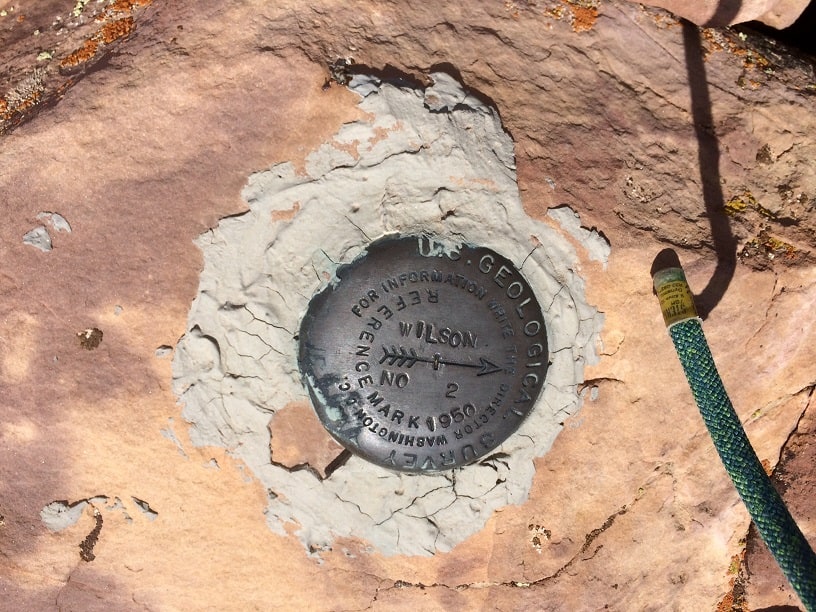 We arrived at the summit at 3:30. Unfortunately, we were still a LONG ways from the car. Using mostly beta from Mountain Project, we decided to take the Oak Creek trail down. We had also read on several comments that there was in fact an easier way to get down into Oak Creek proper. The description, however, was not the greatest. In the end, we hiked for approximately an hour over sand stone and limestone scree, crossed 4 gullies (always staying left, exiting the gullies), and eventually found the “easier gully” for descent down into Oak Creek. We saw this pretty amazing balanced rock on top of a tower as we went down the gully. You can see this tower near the top of the descent gully. If you can’t see this tower, you are in the wrong gully (at least not the gully we went down). There was one section of static rope that required a “bat man” hand over hand descent down a slab face for about 30 feet. Not a bad ordeal. The rest of the deproach down this gully was quite straight forward and non-technical. I would say this would be the safest descent in the dark, although I wouldn’t want to try it.
We arrived at the summit at 3:30. Unfortunately, we were still a LONG ways from the car. Using mostly beta from Mountain Project, we decided to take the Oak Creek trail down. We had also read on several comments that there was in fact an easier way to get down into Oak Creek proper. The description, however, was not the greatest. In the end, we hiked for approximately an hour over sand stone and limestone scree, crossed 4 gullies (always staying left, exiting the gullies), and eventually found the “easier gully” for descent down into Oak Creek. We saw this pretty amazing balanced rock on top of a tower as we went down the gully. You can see this tower near the top of the descent gully. If you can’t see this tower, you are in the wrong gully (at least not the gully we went down). There was one section of static rope that required a “bat man” hand over hand descent down a slab face for about 30 feet. Not a bad ordeal. The rest of the deproach down this gully was quite straight forward and non-technical. I would say this would be the safest descent in the dark, although I wouldn’t want to try it.
We also disrupted a herd of probably 20 big horn sheep who were hanging out near the balanced rock. If I had to guess, I would say the balanced rock formation is around 100 feet tall, possibly more. Fantastic!
The rest of the “deproach” was a typical Red Rock experience. Scramble down a sandstone slab, scramble over boulders in a wash, find a trail and hike out. The total time back to the car from the summit was 4 hours. Both Ash and I were completely exhausted on the hike out. We had barely any water left, and as such, didn’t want to eat anything. I remember feeling really exhausted, taking a sip of water, and feeling a temporary boost in energy 30 seconds later. We were both afraid to sit down and rest. We weren’t sure we would be able to stand back up and continue hiking if we sat down! We encouraged each other by talking about what we wanted to rehydrate with. Ash was envisioning a Big Gulp of Dr. Pepper, and I was envisioning a Seven Eleven cherry smoothie.
All in all, our trip took us 14 1/2 hours from car to car. We arrived back at the car at about 8:00 PM, but before dark! A very very long day. I was stoked to have completed my first Grade V climb. I couldn’t believe the difference between Grade IV and Grade V. Such a huge gap between the two. Here’s a picture of how we felt at the end of the day and on the drive home (somewhat dramatized).
My experience in this adventure gave me a lot of respect for the Grade V rating on climbs. I have never been so spent after a day of climbing! I definitely suffered from a Grade V hangover for a couple days after the adventure, but got back on the rock on Tuesday afternoon.
June 4, 2014. Posted by: nelsonday
